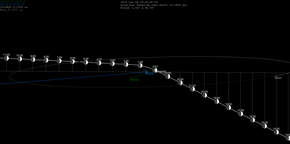 The hourly motion of 2019 AS5 passed the Earth between 7 and 8 January 2019 | |
| Discovery | |
|---|---|
| Discovery site | Mount Lemmon Obs. |
| Discovery date | 8 January 2019 |
| Designations | |
| 2019 AS5 | |
| NEO · Apollo [1] | |
| Orbital characteristics [1] | |
| Epoch 27 April 2019 (JD 2458600.5) | |
| Uncertainty parameter 5 | |
| Observation arc | 1 day |
| Aphelion | 1.8769 AU |
| Perihelion | 0.8188 AU |
| 1.3478 AU | |
| Eccentricity | 0.3925 |
| 1.56 yr (571.547 d) | |
| 98.81126° | |
| 0° 37m 47.528s / day | |
| Inclination | 0.7012968° |
| 106.7463° | |
| 294.359° | |
| Earth MOID | 0.000140 AU (0.054 LD) |
| Physical characteristics | |
| 1–2 m (3.3–6.6 ft) | |
| 32.243[1] | |
2019 AS5 is a near-Earth asteroid that passed close by the Earth on 8 January 2019. It passed within 0.04 lunar distances or 15,000 kilometers of the center of the Earth, 8600 km from the surface. It was discovered by the Mt. Lemmon Survey 9 hours after closest approach. It is estimated to be about 1–2 metres (3–7 feet) in diameter.[2]
As of July 2019[update], it is the closest approach of a non-impacting asteroid in 2019.[3] 2019 MO impacted Earth on 22 June 2019.
- ^ a b c Cite error: The named reference
jpldatawas invoked but never defined (see the help page). - ^ Asteroid 2019 AS5 flew past Earth at a very close distance of 0.04 LD
- ^ Go to https://cneos.jpl.nasa.gov/ca/ and for Table Settings select "Past (within a year)" and sort by "CA distance nominal"